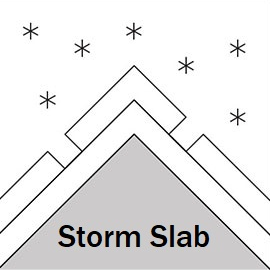Gudauri
Natural avalanches are likely, human-triggered avalanches are very likely. Large avalanches in many areas, or large avalanches in specific areas.
50cm of new snow has fallen up to midday today (Saturday) and it is still snowing heavily. This new snow is likely to form natural storm slab avalanches. It may not bond well with some previous surfaces, and there could also be failures within the new snow layer due to the rapid rate of snowfall. Don't ski off piste or ski tour today. Older wind slabs could still be triggered on some aspects especially where previous crusts or hard surfaces were present. A storm snow avalanche could be a trigger. Weak layers deeper in the snowpack exist in some places and investigation is recommended.
Forecast issued at: 27 January 2024 11:00
Forecast valid until: 28 January 2024 11:00
Forecaster: Manu Greer
High Alpine
> 2600m
4 High
Very dangerous avalanche conditions. Travel in avalanche terrain not recommended.
Alpine
2000m - 2600m
4 High
Very dangerous avalanche conditions. Travel in avalanche terrain not recommended.
Sub Alpine
< 2000m
4 High
Very dangerous avalanche conditions. Travel in avalanche terrain not recommended.
Avalanche Problems
Storm Slab

50cm of new snow has fallen up to midday today (Saturday) and it is still snowing heavily. This new snow is likely to form natural storm slab avalanches. It may not bond well with some previous surfaces, and there could also be failures within the new snow layer due to the rapid rate of snowfall. Don't ski off piste or ski tour today.
| Sensitivity | The specific avalanche problem type is highly reactive to human rider triggers. |
| Distribution | Many locations. Evidence for instabilities is frequently found, in many locations. |
| Time of Day | All day |
| Trend | Deteriorating |
| Confidence | Moderate |
Wind Slab

Wind slabs formed Jan 24th on SW, S and SE aspects then NE and E aspects with a change in wind direction. These are now stabilising but In some places they are sitting on a sun crust or a hard wind-scoured surface and may not be very well bonded. Storm snow avalanches could trigger these slabs. Watch for cross-loaded gullies where the slabs could be present on unexpected aspects.
| Sensitivity | The specific avalanche problem type is difficult to trigger with a human rider. |
| Distribution | Specific areas, with common characteristics. Evidence for instabilities exists, but it is not obvious and finding it requires careful observations. |
| Time of Day | All day |
| Trend | Improving |
| Confidence | Moderate |
Persistent Slab

Weak layers associated with melt-freeze crusts or density changes have been found in a couple of spots around the forecast area, and cold temperatures are likely to be making these layers weaker. These weaknesses probably need a large load to set them off, but with new snow adding weight, watch this space! Probably only found in isolated areas, although there is still uncertainty - we need more information, so please let us know what you find out there.
| Sensitivity | The specific avalanche problem type is difficult to trigger with a human rider. |
| Distribution | A few, isolated locations; evidence for instabilities is rare and hard to find. |
| Time of Day | All day |
| Trend | No change |
| Confidence | Moderate |
Recent Avalanches and Snowpack
Avalanche Activity:
25th January - natural size 1 windslab observed, S aspect 3000m (happened on 24th)
24th January - 2 x skier-triggered size 1windslabs, SW and W aspects, Bidara W, 2700m. Size 1 loose dry slides observed, steep high alpine areas.
Snowpack:
Significant amounts of new snow are stacking up on Saturday, and this new layer will be unstable for at least 24 hours after the end of the storm. Previous windslabs at higher elevations are are becoming less reactive. The deeper snowpack is generally stable, with melt-freeze cycles at lower elevations (below 2000m) solidifying the snow and rercent warm temperatures creating a crust below 2600m and up to 3000m on sunny S faces. In some areas higher up (above 2600m), weak, faceted snow was found in shallow rocky areas near ridges, and a crust/facet layer was also seen around 3000m, E aspect. With colder temperatures these layers will need to be watched carefully. Some questions remain about surface hoar under the recent snow which may have survived in sheltered areas above about 2500m, but we have not yet seen evidence that this is a problem. Remember that glide cracks and glide slab avalanches are an ever-present danger in this area, and they release at random times - don't stop below them. They can be disguised by new or wind-drifted snow. Check out recent snow profiles (or add your own!) at snowpilot.org
Weather
Cold temperatures over the last 3 days, with N/NW winds on the 24th switching to SW winds on the 25th, lighter winds on 26th. Heavy snow is forecast on Saturday 27th (50cm by 13.00 measured at the snowpark lift) with light to moderate N winds forecast. Freezing level 1300m.
Disclaimer
Our avalanche forecasters are internationally qualified and experienced professionals, and data is provided by skilled observers. We encourage you to make your own observations and decisions, without relying solely on our forecast, since any forecast is a generalised 'best guess', and in certain cases it might be inaccurate. We can not be held liable for any actions you take in the backcountry that may result in injury, loss or death.